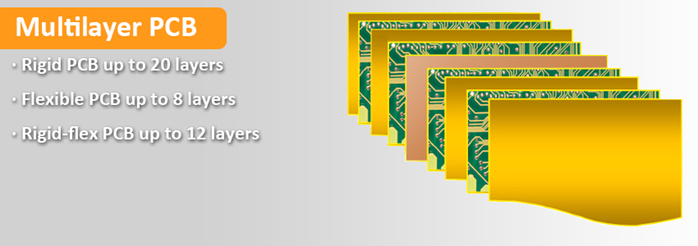
Printed circuit boards (PCBs) are the main board of all electronic products, determining functions through combinations of pass and active components and traces routing. When the multilayer PCB was invented in 1961, the multilayer boards were relatively simple which limited by manufacturing techniques at that time. While nowadays circuit boards are much more complex in schematic and routing, and multilayer circuit boards are widely used in all kinds of electronics in the world.
Printed wiring boards (PWBs) for simple electronics with limited functions are usually composed of a single or double layer. More complicated electronic applications, like 4G/5G smart phones, tablets, PCs, GPS, high-end earphones, fire alarms, heart monitor, X-ray and CT scan equipment and industrial controls, and etc. consist of multiple copper layers. With the increasing complexity of modern electronics, these multilayer PCBs with significant board size down become more widespread than ever before which contributes to advanced design software, enhanced manufacturing techniques, the art-of-work equipment, new chemicals and materials.
Manufacturing Multilayer PCBs
- Rigid PCB up to 20 layers
- Flex Circuit up to 8 layers
- Rigid-flex PCB up to 12 layers
The demand for multilayer boards has been on the rise. What
has made the multilayer PCB much more popular are the electronics to be smaller, faster and more functional. As a leading supplier of multilayer printed circuit boards, which are more complex and have a variety of differences from the standard single-sided and double-sided PCBs, the ability to manufacture multilayer PCB boards opens up a world of possibilities allowing the electronic engineer to create more densely populated circuit boards which allows miniaturization.
View Our PCB Manufacturing Capabilities
Flexible and Rigid-Flex PCB Capabilities
What is a Multilayer PCB?
Multilayer printed circuit board is made with three or more conductive copper layers, set right in the middle with multiple other layers stacking on this core. In many cases, these other layers are copper foil, the material in-between cores or copper foils is Prepreg. As a smart multilayer PCB provider, we can work with you to support a large panel of materials. All electrical connections between the layers are achieved with vias, including but not limit to plating through holes (PTHs), blind and/or buried vias. Application of this Build-up method then leads to the generation of highly complex PCBs.
How to Manufacture a Multilayer PCB?
Manufacturing multilayer PCB boards start by creating the PCB core. Layers of copper foil, prepreg and core material are built up and combined together under high temperature and pressure to produce multilayer printed boards. Pressure is required to squeeze out air in the laminated materials, and accelerating the combination of copper layers and prepreg under heat, while heat is required to melt and cure the thermosetting prepreg adhesive which holds the multilayer PCB together. Sounds simple, but the whole process is time consuming and counting on skilled technicians.
Multilayer circuit board fabrication is a straightforward process but does require a high level of attention to detail. Skill and care must be taken to ensure all copper layers are correctly registered to the required drilled holes despite the deformation stresses produced by the heat and pressure. The buildup requires the operator ensures correct materials are chosen, the build sequence is followed and the orientation of each sheet is correct. Each un-pressed PCB panel is loaded, 10 panels are stacked together with heavy steel plate in-between each panel, then loaded to the big lamination machine to meet high pressure and temperature. At our PCB manufacturing house, we have capacity to press up to 25 panels in each load. The process for pressing polyimide material is modified slightly from the process required for FR-4.
DFM for Multilayer PCB Boards
- All copper on inner layers should be kept at least 10mil to 20mil from the outer edge of the PCB board.
- Via clearance through inner layers
- 15mil to 20mil clearance around any holes or via barrels not connected to an inner layer is acceptable.
- The tie of thermal relief pads should be a minimum of 8mil.
- For future mass production, mechanical thru-holes with diameter at least 8mil (0.2mm) is recommended.
Multilayer PCBs’ Bow and Twist
Bow and twist is more likely to occur in asymmetric designs which can result in unbalanced stress conditions. For example, odd layer counts (3, 5 layers) are known to cause bow and twist issues. Another source of multilayer PCB’s bow and twist comes from designs which specify variable layer thicknesses. For example, a 4-layer build specification of 7/28/21 creates more risk of deformation than a standard build. Even different circuit configurations can be influencing factors. What’s more, asymmetric copper thickness also causes bow and twist issues.
Choosing the Right Multilayer PCB Manufacturer and Supplier
We support 3 to 20 layers multilayer PCB prototypes and mass production with strictest manufacturing standard. The processes to manufacture multilayer printed circuit boards require specialized equipment and significant commitment to operator training. This is why some PCB fabricators have been slower to enter the multilayer manufacturing than others. We can provide the expanded capacities to support complex printed circuit board with requirements including laser drilled microvias, via-in-pad, heavy copper up to 10 oz, 1+n+1 to any layer interconnect boards, up to 20 layers.